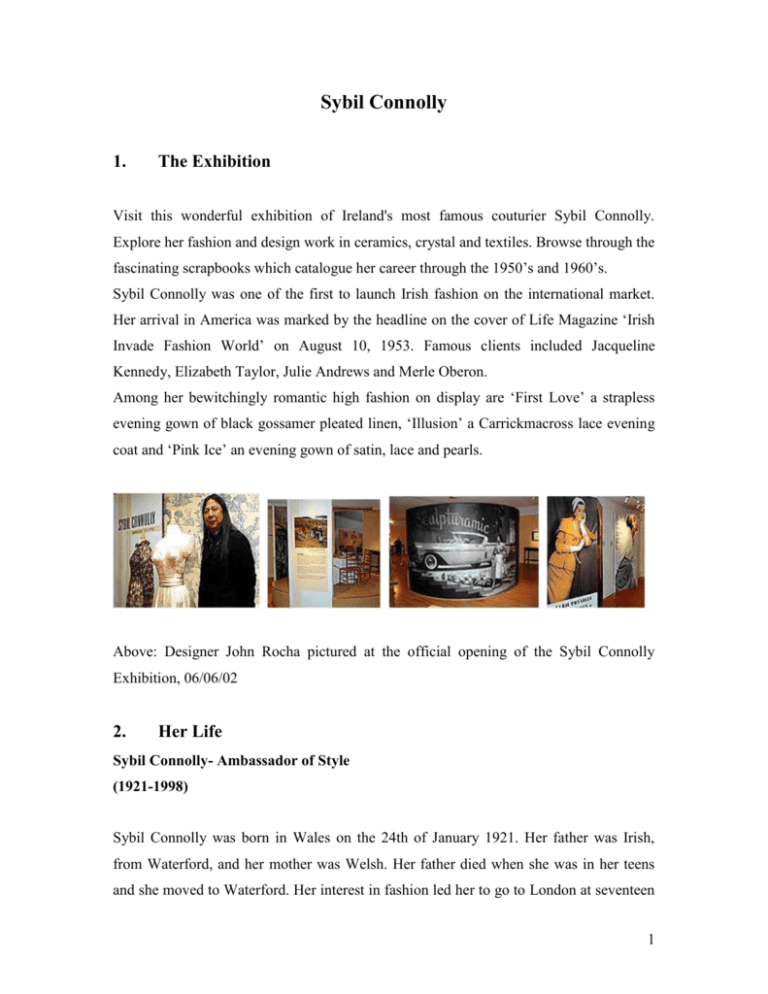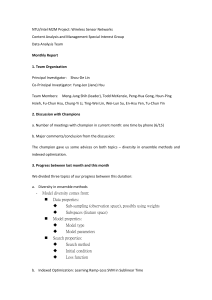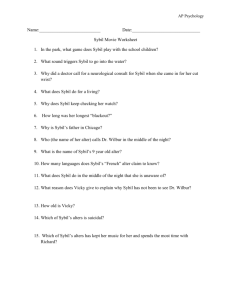here - Hunt Museum
advertisement

Sybil Connolly 1. The Exhibition Visit this wonderful exhibition of Ireland's most famous couturier Sybil Connolly. Explore her fashion and design work in ceramics, crystal and textiles. Browse through the fascinating scrapbooks which catalogue her career through the 1950’s and 1960’s. Sybil Connolly was one of the first to launch Irish fashion on the international market. Her arrival in America was marked by the headline on the cover of Life Magazine ‘Irish Invade Fashion World’ on August 10, 1953. Famous clients included Jacqueline Kennedy, Elizabeth Taylor, Julie Andrews and Merle Oberon. Among her bewitchingly romantic high fashion on display are ‘First Love’ a strapless evening gown of black gossamer pleated linen, ‘Illusion’ a Carrickmacross lace evening coat and ‘Pink Ice’ an evening gown of satin, lace and pearls. Above: Designer John Rocha pictured at the official opening of the Sybil Connolly Exhibition, 06/06/02 2. Her Life Sybil Connolly- Ambassador of Style (1921-1998) Sybil Connolly was born in Wales on the 24th of January 1921. Her father was Irish, from Waterford, and her mother was Welsh. Her father died when she was in her teens and she moved to Waterford. Her interest in fashion led her to go to London at seventeen 1 to study dress making with the firm Bradley & Co, who had among their clients members of the British Royal family. She returned to Ireland at the outbreak of World War II and lived there for the rest of her life, making her home at 71 Merrion Square Dublin. She died in I998. Sybil Connolly was a pioneering designer in Ireland and one of the first to have international success, especially in America. She was among a group of Irish designers, in the 1950’s and 60’s, such as Irene Gilbert and Nelli Mulcahy who’s designs were inspired by native fabrics, turning them into high fashion garments. Later in her career she turned her attention to interior decoration and designed crystal, fabric and ceramics. Her natural style and charm made her an outstanding Ambassador for Ireland. 3. Her Fashion Sybil Connolly joined the fashion house of Richard Alan, which was owned by Jack Clark, in the early 1940’s after returning from London where she had studied dress making at Bradley & Co. She was employed initially as manager rather than designer. When their designer, Gaston Mallet left the company in 1952, Sybil was offered the job of designing the next season's collection. She did so with great success. The textiles she used such as tweed, crochet and lace in striking, vibrant colours, were produced in new weaves and weights making them particularly attractive to the American market. Her trademark fabric was pleated handkerchief linen. It took nine yards of this very fine linen to produce one yard of the finished cloth. In July 1953, Carmel Snow, Editor of American Harpers Bazaar, brought a group of fashion press and buyers to Ireland. They were entertained by Lady Sheila Dunsany who was one of the first to spot and encourage Sybil. These events launched Sybil’s 2 international career. It was about this time she was introduced to Eleanor Lambert, New York’s doyenne of fashion. She and Sybil became life-long friends. Both she and Carmel Snow promoted Sybil in any way they could. While her character was unquestionably tough, she had great charm. American department store executives were charmed by Sybil’s smiling hazel eyes but found themselves dealing with an astute businesswoman. She knew how to keep her name in the news and featured regularly in gossip columns. Some of her high profile clients included Jacqueline Kennedy and members of the Rockerfellers, Mellon and Dupont families, Merle Oberon, Elizabeth Taylor, Rosalind Russell, Dana Wynter and Julie Andrews. March 1957 saw Sybil’s departure from Richard Alan and the opening of her own fashion house, at 71 Merrion Square; this was also to become her home. During the sixties fashion changed, but Sybil was unwilling to change her style. In 1970 her comment, "I never liked the mini and I always remember what Dior once said to me in Paris" "A woman should show her curves not her joints" and this was so true, she said. She continued to produce her classic designs through out her life for her dedicated clientele. 4. Fabrics, Tablewear and Interior. In the 1970’s and 80’s Sybil turned her attention to other areas of design. These included Interior design, ceramics and crystal. She designed fabric, wall paper and bed linen for such company’s as Brunschwig et Fils, Schumacher and Martex. A range of ceramics 3 were designed for Tiffany and Co, Bloomingdale’s and Marshall Field’s as well as a cut for Tipperary Crystal. She also designed interiors and advised on the decoration for the Swiss Cottage in Co. Tipperary when it was being restored and another cottage orné in Philadelphia. Sybil collaborated with many artists and crafts people to produce these designs. Wendy Walsh and Adrienne Symes, two botanical Illustrators, worked with her on many of the designs for ceramics and fabrics. The table ware designed for Tiffany’s was based on "Mrs. Delany Flower collages" from the 1700’s. Also designed for Tiffany was "Celtic weave" pottery produced by Tommy Daly, Tipperary crystal and ceramics by Nicholas Mosse. The world of books featured in Sybil’s varied career with In an Irish Garden edited by Sybil Connolly and Helen Dillon. In 1988 In an Irish House was followed by Irish Hands which includes the various craft people with whom she worked. 5. Inspiration Sybil Connolly’s own house and garden as well as the Irish country side and Ireland's Georgian heritage were recurring themes in all elements of her design work. Her garden was one of her great joys and she planned it, as she said, "for the pure love of flowers and as a place where she could find enormous pleasure". Her favourite flowers, Lily of the Valley, dianthus and roses, appear frequently in her designs. The colours of the Irish countryside are reflected in the fabrics for both her clothes and interiors. She also found inspiration from Georgian architecture; of her own 18th century house at 71 Merrion 4 Square she said "after 31 years I still pause to admire the beauty of the proportions of the rooms". The plasterwork on the ceilings of Leinster House were reproduced on skirts and dresses from her earliest collections. Designs taken from 18th century fabric and paintings, especially bows, recur frequently in her work. The picture of Ireland reflected in her designs was idealised. She combined elements from mythology, traditional clothing and aristocratic living to produce highly romantic designs. This reworking of traditional styles and forms produced high fashion garments that fitted perfectly the mood of the times. Mary Granville Delany (1700-1788) was considered to be one of the most witty, intellectual, artistic accomplished and charming women in eighteenth century England and Ireland. She mixed in the highest social circles and was a friend of King George III and Queen Charlotte, Dean Swift, Horace Walpole Edmund Burke and Handel among others. She married Dr Patrick Delany, Dean of Down, in1743 and came to live in Ireland in both Dublin and Down Patrick. She returned to London after her husbands death in 1768. Throughout her life she produced exquisite embroidery, decorative shellwork and landscape sketches inspired by her love of nature. She created her most extraordinary work between the ages of seventy-three and eighty-two when she made nearly 1,000 collages from hundreds of pieces of coloured paper, each rendering in minute detail a different flower. Sybil Connolly’s admiration of Mrs Delany's work led her to organise, with Professor Charles Ryscamp, an exhibition of Mrs Delany's collages at the Pierpont Morgan Library in New York in 1986. She had been asked to design china by John Loring for Tiffanys earlier that year and she decided, in order to draw attention to the exhibition, to use designs which echoed Mary Delany's collages. In order to bring these designs to fruition she collaborated with Wendy Walsh one of Ireland's foremost botanical illustrators. The exhibition and the china proved a great success. 5









